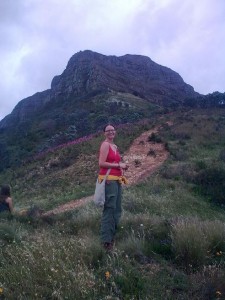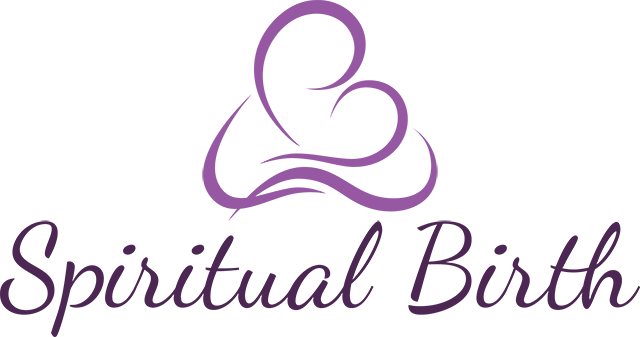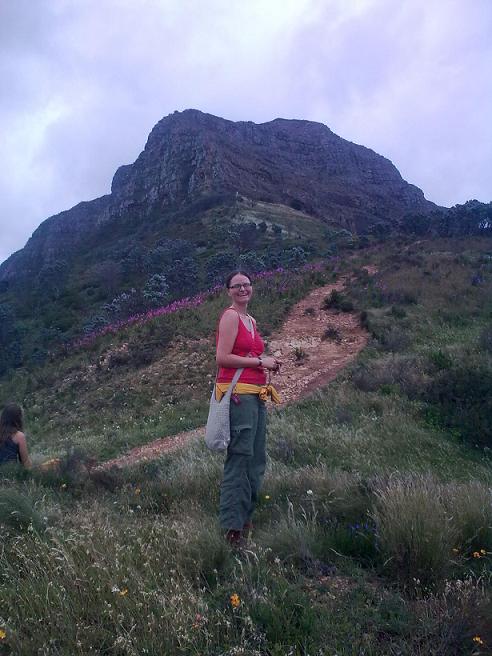I promised a few months ago to post more on indigenous traditions in South Africa. Well here comes a snippet. It’s a pity western women are so afraid of birth. We hardly believe birth is normal any more and are SO afraid of the pain or anykind of discomfort. We have devised all sorts of gadgets to help us manage our babies, so as to free ourselves from what we perceive as the burden of giving birth and taking care of them. I’m not so sure that women’s liberation is liberating our children.

South Africa is today a country of many cultures, languages and traditions. Yet at one time, the area was populated only by an original group of indigenous people: the Khoisan Bushmen. The Khoisan people were hunter gatherers, living in harmony with the ecosystems of the time; a magnanimous variety of plants and teeming game provided them with everything they needed for a harmonious life.
The !Kung are a particular small group of San nomadic hunter-gatherers who today still strive to live in relative harmony with the eco-system. They live in small groups and settle in tents or shelters made from locally available materials such as twigs, grasses or reeds until resources become scarce. The search for new resources will move the group to a new site.
Men are the hunters and bring home the meat of wild animals they have managed to kill, while women are gatherers of roots, wild vegetables, fruits, berries and water, as well as the materials used to provide shelter. Men are as highly respected for their hunting and tracking skills and their knowledge of the natural environment as women are equally respected for their knowledge of edible plants and abilities to find water, and especially their ability to give birth and nurture their young. Khoisan tribes who have been studied by anthropologists, including the !Kung, has show that not only do they have a vast knowledge of the plant and animal life, but also a sound knowledge of women’s monthly cycles according to the moon, knowledge that pregnancy occurs through sexual intercourse and knowledge of the average length of a pregnancy.
How San Bushmen Approach Motherhood
Motherhood, amongst the San Bushmen, brings status and social recognition to the young girl after she has navigated the journey of pregnancy and birth. Unlike our attitude in the western world where women are offered pain relief at the slightest twinge that labour may have begun, a young !Kung woman is actively taught that she must face the pains of natural childbirth with courage and fearlessness. Most women will give birth alone in a squatting position, some few hundred metres from their settlement, and this is regarded as ideal, although mothers giving birth for the first time may have a helper at hand.
Bringing a child into the world is a gift to the tribe and a young mother is taught that how she feels and thinks during the pregnancy will affect the labour and birth of the new baby. Other members of the group will assist by helping to carry other children or food, yet a pregnant woman is expected to continue with her normal duties such as gathering food, cleaning, caring for other children and should not complain. This renders a woman fit and healthy during her pregnancy – there is no room for slothfulness or overeating in this society, a pregnant woman is rarely overweight and an unborn baby is likely to grow to be the right size for the mother to give birth.
Giving birth alone is a tremendous experience for the first time mother among the San Bushmen, and many young girls are encouraged to watch another woman giving birth so that they learn to face their fears. They occasionally talk about their fears to other woman in the group, but most young girls will stoically accept that this path is part of their future. The maternal death rate amongst the !Kung was very low at 0.4% in the 1980’s when many studies of the San people were done, though infant mortality rates are higher and losing an infant or young child to sickness is a common experience among !Kung women.
It appears that San women bite the cord with their teeth and bury the placenta after giving birth, before walking back to the settlement. This is her duty, to return the placenta, which is no longer needed, to mother earth. It also connects the infant to the territory a particular group of Bushmen clan occupy. Perhaps the nomadic lifestyle of hunter-gatherers means that not much ritual was performed on the burial of the placenta, unlike the pastoralists and agricultural Bantu people.
Traditional Bantu Birth
Birth among the Bantu people was traditionally attended by an older woman such as a grandmother or a traditional birth attendant. After a birth, the mother is secluded in her hut with the baby until she stops bleeding and burial of the placenta and cord has great importance. When the cord falls off, it is understood that the newborn now not only belongs to the mother, but to the whole community. Traditionally an animal is slaughtered as a sacrifice and the skin of the animal is given to the new infant as a protective clothing or sleeping mat. The burial spot of the placenta seals the attachment of a person to their ancestral land and it is a place to which many will return as adults. This burial place of the placenta is a place to connect with their ancestors in times of trouble, to dream and eventually to die. All African cultures believe that a new baby has come from the spirit world bearing gifts and talents. The naming ceremony is therefore of vital importance, connecting a baby to the ancestors who have imparted these talents and bonding the newborn to the community.
A Khoisan woman will instinctively know when her baby needs to urinate or pass a stool and will hold the baby away from her body to perform the function. She is attuned to her baby’s need for warmth, closeness, movement, elimination, hunger and is able to meet her baby’s needs without resorting to extensive efforts or tools. Her breasts are clean and the milk is sterile with all the correct nutrients for his growth. Social interaction is an integral part of this attunement, so the baby learns that co-operation and communication are the pillars of his survival and comfort levels. He also learns as he is able to toddle, walk and later run, that he has an important function to fulfil in the life of the community, that he has tasks and duties to fulfil as he grows into adulthood.
Children are the continuation of life – togetherness is essential for this continuation, no individual acts in isolation from the group or clan. Children bring much joy to the clan and provide great amusement when the group gathers around the fire or eats together. Children learn from early on that co-operation and friendliness are valued highly.
Umuntu, Umuntu, Ngabantu!
I am because you are!
A person is a person in relation to other persons!
We surely could learn a thing or two from our ancestors and the !Kung people!


i find it interesting
I love this! Thank you for sharing! I was just searching for where indigenous woman give birth and it seems that many of them do so outside of the home and mostly alone or with one birth attendee! Interesting! Also, I love to hear about the placenta. That makes so much sense to me. I’ve still got my daughter’s placenta in the freezer! I keep thinking that one day I will have a little ceremony and throw it into the ocean where we live
You are doing good work,but do you think it’s fair for these women to bring a child int the world in which they cannot give it what that child needs? Healthy eating,drinking water, and general healthy lifestyle?tv shows so much how much child suffering there is there,why bring a child into that environment?
We ARE these women. Who are we to judge fairness in the world? Is it fair for any person who is dealing with personal and social problems to bring a child into the world? Life is not about fairness, it is about life and learning, what we are given and what we are here to give. It is a journey not a destination and we are all growing through the process. Perception is all.
Great reply!!!
It makes sense to return a soul to where it once came when one is received. Does it not?
I take it Louise is vegan?
Can you share the references for the information? You did not site any source of information.
Much of my information came from the following book: ^ Shostak, Marjorie “Nisa: The Life and Words of a ǃKung woman, ISBN 0-674-00432-9, pp. 77-81, 2nd edition 2006, Harvard University Press, I hope this helps.
I like to think of it as spiritual, man thanking God for the gift of life, by offering him a sacrifice in return.
Besides, they probably use every part of the animal, unlike the wasteful western culture we are a part of.
Amazing people!
Thankx for the gud works done. I look forward to working with u in da near future.
killing an animal because a baby was born….? I think not.
Yes! Killing Animals is still very much part of African ritual culture in Southern Africa and may still be practiced in very rural areas. Over the lasr 300 years though, large portions of the African people haveconverted to Christianity and many traditional practices have ceased or become Westernized/Christianized. There are now small groups of activists who are campaigning to stop the ritual slaughter of animals in South Africa.
Correct I full agree